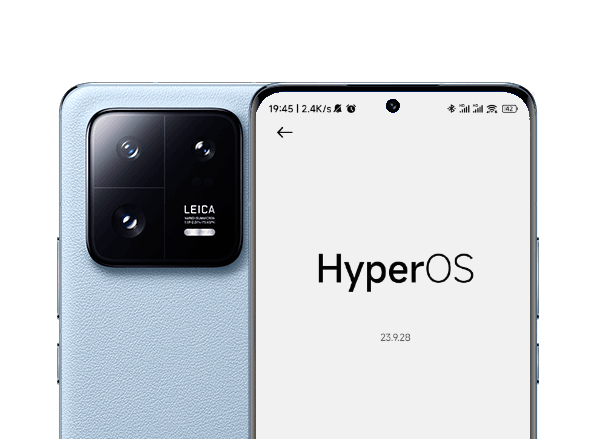Xiaomi’s HyperOS: Charting the Path to a Unified Tech Ecosystem
Xiaomi, a prominent tech juggernaut based in China, has set the tech world abuzz with its recent unveiling of HyperOS, a cutting-edge operating system. This groundbreaking software was introduced alongside the debut of Xiaomi’s latest smartphones, the Xiaomi 14 and Xiaomi 14 Pro, in China. HyperOS signifies a significant departure from Xiaomi’s long-standing MIUI operating system, a mainstay of Xiaomi’s Android devices for the past 13 years. Yet, HyperOS is not just a successor to MIUI; it is a pivotal part of Xiaomi’s broader strategy to unify its entire product ecosystem, stretching beyond smartphones to encompass smart home devices and future ventures such as connected cars. In this article, we’ll delve into the intricacies of Xiaomi’s HyperOS, its potential impact, and the uncertainties surrounding this ambitious undertaking.
HyperOS: More Than a Mere Operating System
HyperOS isn’t a mere substitute for MIUI; it serves as a unified umbrella brand for Xiaomi’s operating systems spanning its complete product range. This expansion transcends smartphones, encompassing products like the Xiaomi Watch S3, Xiaomi TV S Pro 85-inch MiniLED TV, and other components within Xiaomi’s burgeoning ecosystem. This strategic move aims to offer users a seamless experience across diverse product categories.
The Dual Nature of HyperOS
While one might initially assume that HyperOS is a singular, monolithic OS designed to power all Xiaomi devices, the reality is more nuanced. Xiaomi’s approach with HyperOS adopts different foundations for distinct products. HyperOS employs the open-source Xiaomi Vela platform, built upon the open-source RTOS, NuttX, for Internet of Things (IoT) devices. In contrast, for smartphones and tablets, HyperOS relies on the Android Open Source Project (AOSP).
Notably, Xiaomi smartphones will maintain robust compatibility with Android applications, thanks to their AOSP foundation. The Android version serves as an independent component, separate from the HyperOS version. For instance, the newly launched Xiaomi 14 and Xiaomi 14 Pro come equipped with HyperOS v1 based on Android 14, while the Xiaomi Pad 5 will soon receive an update to HyperOS v1 based on Android 13. This approach ensures that users have access to the latest Android features and apps, complemented by Xiaomi’s customized HyperOS.
An Evolution from MIUI
For those familiar with Xiaomi’s MIUI, the question arises: how different is HyperOS? Thus far, it appears that HyperOS on Xiaomi smartphones can be perceived as an evolution of the MIUI 14 experience. While some user experience aspects have undergone changes, such as new lockscreen customizations, the fundamental MIUI essence remains evident in various system applications.
Xiaomi asserts that HyperOS is naturally lightweight, consuming a mere 8.75GB of storage on smartphones. On devices with limited processing power, HyperOS incorporates scheduling changes aimed at optimizing hardware performance. Moreover, Xiaomi claims that HyperOS delivers a stable frame rate and lower power consumption, particularly during gaming sessions, compared to stock Android.
The Technical Transformation of HyperOS
Xiaomi claims to have undertaken extensive restructuring of technical modules within HyperOS, encompassing the file system, memory management, imaging subsystem, and network system. Nonetheless, the specific technical differentiators setting HyperOS apart from AOSP and MIUI remain somewhat elusive. While the company hints at these alterations, a comprehensive technical breakdown of these enhancements has yet to be provided.
HyperConnect: Enabling a Unified Ecosystem Experience
One promising aspect of Xiaomi’s HyperOS is the introduction of the HyperConnect framework, set to be a pivotal feature across all Xiaomi ecosystem devices. Through HyperConnect, Xiaomi aims to seamlessly interconnect its devices, fostering a cohesive ecosystem experience. The implications of HyperConnect are intriguing, as they have the potential to reshape how Xiaomi users interact with their devices. However, the challenge lies in ensuring the coexistence of Xiaomi’s HyperConnect with other initiatives, such as Qualcomm’s Snapdragon Seamless.
AI and Xiaomi’s HyperOS
Xiaomi promises AI-powered enhancements within HyperOS, albeit with some ambiguity. The integration of AI into the broader ecosystem, especially given Xiaomi’s diverse product range, remains unclear. It appears that AI features will be integrated into the AOSP-based HyperOS on smartphones. For instance, the HyperOS Gallery app is set to gain generative AI capabilities, enhancing and expanding existing images.
The Global Rollout of HyperOS
Xiaomi’s CEO, Mr. Lei Jun, has confirmed the international rollout of Xiaomi HyperOS, scheduled to commence in the first quarter of 2024. Nevertheless, the specific products that will receive the initial HyperOS updates on a global scale have yet to be disclosed. This global rollout is highly anticipated as it promises to provide a clearer perspective on Xiaomi’s vision for HyperOS beyond its domestic market.
HyperOS: Opportunities for Enhancement
Amid the excitement surrounding Xiaomi’s HyperOS, some concerns and uncertainties persist. Xiaomi’s decision to brand HyperOS as a singular entity for all its products, spanning smartphones and IoT devices, can be perplexing to some. Many argue that a clearer classification, such as “HyperOS IoT” and “HyperOS Mobile,” could streamline user experience and marketing communication.
Furthermore, it remains uncertain whether HyperOS for mobile devices will address certain issues that users have encountered with MIUI, such as slow updates and aggressive battery optimizations. Additionally, it’s unclear whether all standard Android platform changes, as seen in Android 14, will seamlessly transition to HyperOS. These unanswered questions underscore the significance of the stable global rollout in 2024, which will offer a comprehensive view of the HyperOS experience.
In conclusion, Xiaomi’s HyperOS represents a bold initiative aimed at unifying its entire product ecosystem under a single operating system. While the concept is intriguing, there are concerns and questions regarding its execution and the user experience it will deliver. As the international rollout approaches, tech enthusiasts and Xiaomi users worldwide eagerly anticipate the opportunity to explore the full potential of Xiaomi’s HyperOS and assess how it integrates into their daily lives.
Additional Considerations on Xiaomi HyperOS:
-
HyperOS and the IoT Market: HyperOS could emerge as a dominant player in the IoT market, offering support for a wide range of devices and becoming the preferred operating system for smart homes and other IoT applications.
-
Competitive Edge: HyperOS has the potential to set Xiaomi apart from its competitors in a crowded smartphone market, providing Xiaomi with a unique selling proposition.
-
Developer-Friendly: The unified ecosystem of HyperOS may be a boon for developers, allowing them to create apps that seamlessly work across all Xiaomi devices.
Potential Risks Associated with HyperOS:
-
Complexity Concerns: The wide variety of supported devices and features in HyperOS may introduce complexity, making it challenging to manage and update effectively.
-
User Transition: The transition to HyperOS from MIUI could be disruptive for existing MIUI users if not executed carefully.
-
Security Vulnerabilities: With multiple devices connected to a single ecosystem, HyperOS may become a prime target for security attacks if not adequately secured.








